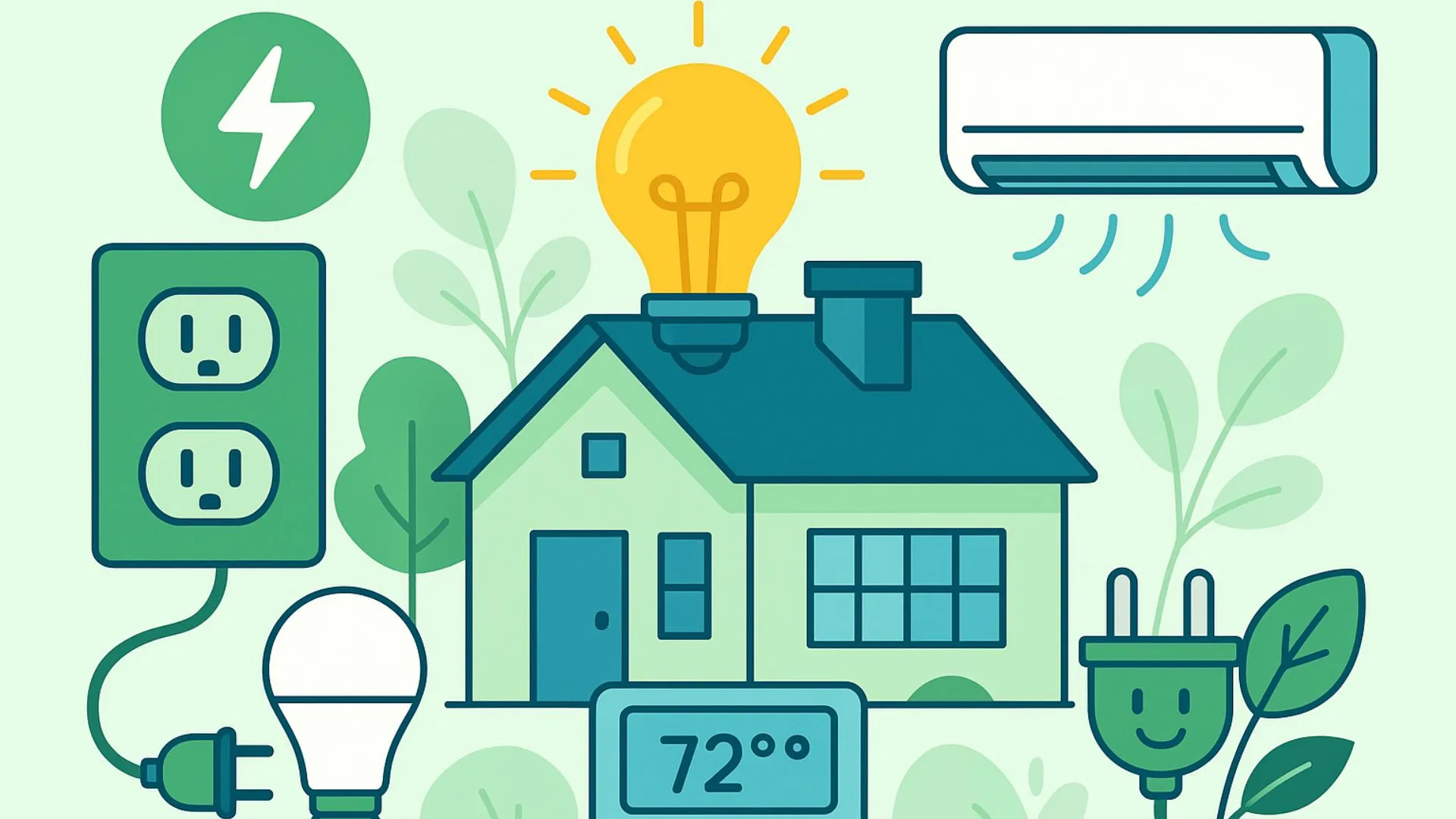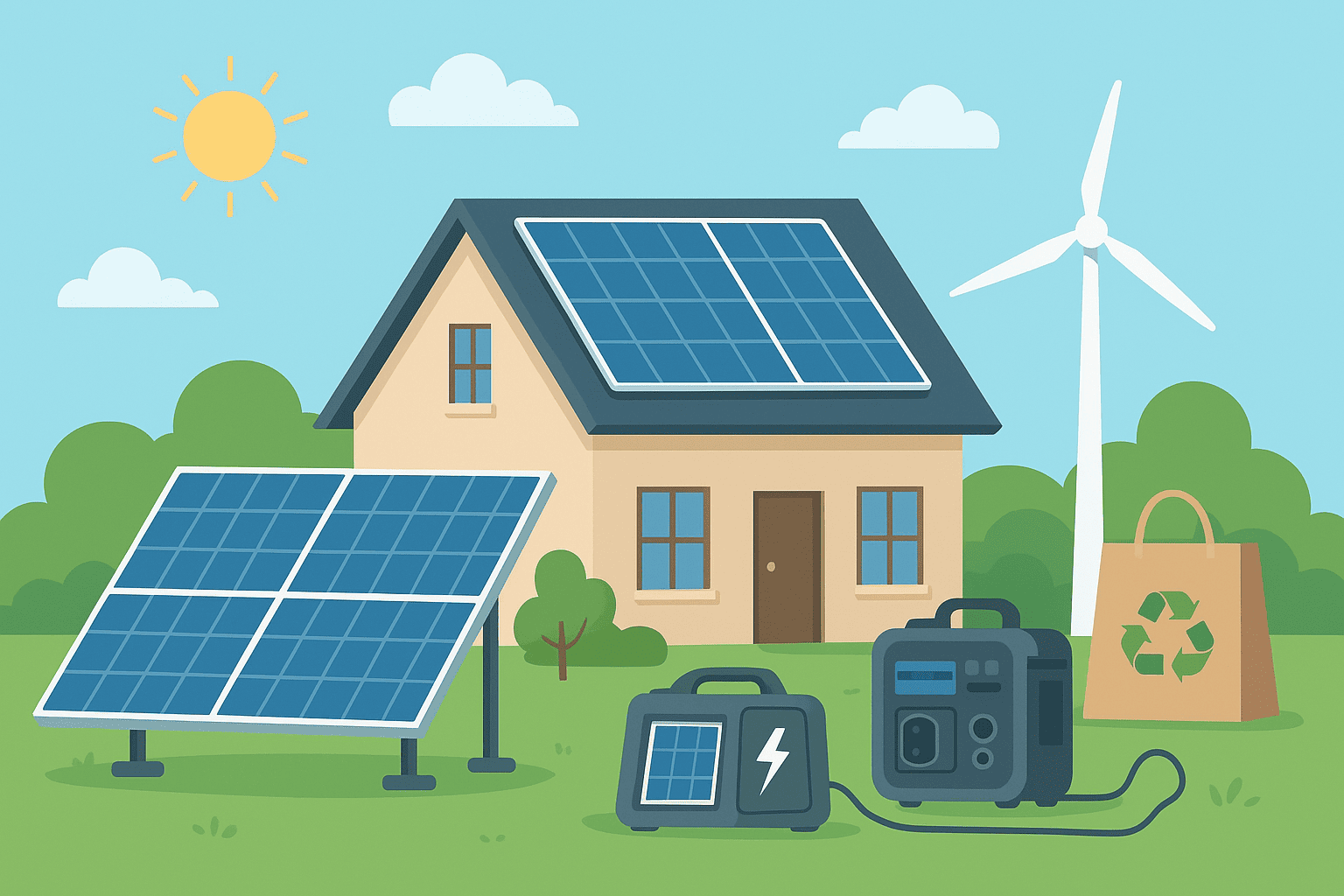⚠️ When shopping for tools and home improvement devices, we strongly recommend checking out Amazon's daily deals for potential savings. These promotions often change, so reviewing them before purchasing can help you find the best price on the right model. Make sure you don't miss out!
📌 This post may contain affiliate links, so we may receive compensation if you purchase products linked to below. As an Amazon Associate, I earn from qualifying purchases. This helps support our work and allows us to create more helpful content for you at no additional cost to you. Read our disclosure for more information.
Introduction 📜
Did you know the average U.S. household spends more than $2,000 a year on energy bills? The good news is that with the right energy-saving devices for your home, you can cut those costs significantly, often by 20–30% annually.
From smart thermostats that learn your schedule to efficient lighting, power strips, and even solar options, modern home energy-saving products can help you save money while reducing your carbon footprint.
This guide explores the best energy-saving devices for home, clears up common myths, and gives you practical tips to maximize efficiency without overspending. For a broader overview of all types of devices, check out our comprehensive guide to energy-saving devices.
1. Best Energy Saving Devices For Home
Energy-saving devices are essential for reducing energy consumption, lowering utility bills, and minimizing environmental impact.
This table provides a concise overview of some of the best energy-saving devices for home use, highlighting their key features and benefits.
By integrating these devices into your household, you can enhance efficiency and contribute to a more sustainable lifestyle.
Top 7 Energy-Saving Devices for Your Home – Ultimate Guide
| Product | Recommended | Features | Benefits/ROI | Rating |
|---|---|---|---|---|
| 1. Smart Thermostat |
ecobee SmartThermostat 
|
✓ Optimizes room temperatures ✓ Open Window Alerts ✓ SmartSensor adjustments |
Reduces heating/cooling by 26%, ROI 2-3 yrs |
|
| 2. LED Light Bulbs |
SYLVANIA ECO LED 
|
✓ 9W brightness 60W ✓ Long lifespan (~7 yrs) ✓ Warm white light 2700K |
Low energy, immediate savings |
|
| 3. Smart Power Strips |
Amazon Basics Smart Strip 
|
✓ Alexa compatible ✓ 3 outlets + 2 USB ✓ Surge protection |
Saves up to $100/year, ROI 1-2 yrs |
|
| 4. Low-Flow Showerheads |
Aqua Elegante 6-Function 
|
✓ 1.8-2.5 GPM ✓ Low-pressure mode ✓ Self-cleaning nozzles |
Reduces water heating, ROI 1-3 yrs |
|
| 5. Solar Panels |
Jackery SolarSaga 100W 
|
✓ 23% efficiency ✓ IP65 water-resistant ✓ Flexible kickstand setup |
Up to 100% energy needs, ROI 1-5 yrs |
|
| 6. Tankless Water Heaters |
Ecotouch Tankless (Electric) 
|
✓ Instant hot water ✓ Touch controls ✓ Up to 60% energy savings |
30% more efficient than tanks, ROI 5-10 yrs |
|
| 7. Ceiling Fans |
Hunter Crestfield LED Fan 
|
✓ LED light kit ✓ Whisper wind motor ✓ Low-profile flush mount |
Cuts energy costs 20-30%, ROI 1-3 yrs |
|
2. Key Types of Energy Saving Devices for Home
There are plenty of different energy-saving devices for home use, ranging from smart thermostats and efficient lighting to solar panels and water-saving fixtures. Each plays a unique role in lowering utility bills and reducing environmental impact. In this section, we’ll highlight some of the most effective options available today — and since new technologies are constantly emerging, we’ll continue expanding this list to keep you updated with the latest ways to save energy at home.
2.1 Smart Thermostats
Smart thermostats like Ecobee and Nest automatically adjust heating and cooling based on your daily schedule, home occupancy, and even outdoor weather conditions. By optimizing energy use, homeowners can save $150–$200 per year on electricity bills. Many models also include features like geofencing, adaptive schedules, and remote control through mobile apps, making them a convenient and efficient choice for energy-conscious households. Additionally, many utility companies offer $50–$100 in rebates when installing a smart thermostat. For more information on selecting and using smart thermostats, see our full guide.
2.2 Smart Lighting Solutions
Smart switches allow you to control multiple fixtures at once, reducing wasted electricity, while smart bulbs offer scheduling, dimming, and even voice control for greater convenience and efficiency. Replacing just 10 traditional bulbs with energy-efficient LEDs can save over $100 annually, making lighting upgrades a simple way to reduce your electricity bills. For a detailed guide on selecting the best options, see our guide to energy-efficient light bulbs.
2.3 Smart Power Strips & Outlets
Standby power, often called “vampire energy,” can account for 5–10% of your household energy bill. Smart power strips automatically cut power to devices when not in use, helping reduce wasted electricity — learn more in our guide to smart power strips. Smart plugs let you track consumption and schedule devices like water heaters or coffee makers, cutting unnecessary runtime and lowering costs; see our guide to smart plugs for details. For common myths and scams around these devices, check our myths and realities of plug-in energy savers and efficiency of energy saving plugs.
2.4 Water-Saving Devices
Low-flow showerheads help reduce hot water usage, saving both water and energy, while contributing to a more sustainable household. For guidance on selecting the best models, see our guide to low-flow showerheads. Smart irrigation systems, such as controllers like Rachio 3, optimize outdoor watering schedules to reduce water waste and lower utility bills, making them an efficient solution for energy- and water-conscious homes.
2.5 HVAC Helpers (Sensors, Fans, Blinds)
Occupancy sensors help ensure lights and HVAC systems run only when needed, reducing wasted energy. Smart blinds can regulate indoor temperatures by blocking heat in the summer or letting in sunlight during the winter, while ceiling fans improve airflow and reduce HVAC load. For a deeper dive into practical home energy efficiency strategies, see our post on Top Strategies to Boost Your Home's Energy Efficiency.
2.6 Renewable Energy Devices For Home
Solar panels, whether rooftop or portable, can offset a significant portion of your electricity use, making them a key investment in home energy efficiency. For guidance on choosing the right system, see our solar panel guide. Battery storage solutions allow you to store excess solar or wind energy for later use — learn more in our battery storage guide. Tankless water heaters provide hot water on demand, reducing standby heating losses. For full smart energy management solutions, see our home energy management systems guide.
3. Do Energy Saving Devices Really Work?
3.1 Understanding the Skepticism
Some homeowners are hesitant to invest in energy-saving devices due to upfront costs — for example, a smart thermostat can cost around $200, while a tankless water heater may exceed $1,000. There is also concern about fraudulent or ineffective products, such as “power saver boxes” and similar plug-in devices that claim to reduce electricity bills through power factor correction, which is only effective in industrial settings. Understanding the true benefits and limitations of energy-efficient appliances and smart home devices can help homeowners make informed decisions, maximize energy savings, and reduce utility bills.
3.2 Energy-Saving Myths vs. Reality
| Myth | Reality |
|---|---|
| “Cheap plug-in energy savers reduce home electricity bills.” | ✗ False — these are scams, proven ineffective in residential settings. See Energy Saving Plugs: Efficiency or Scam?. |
| “Smart thermostats don’t make much difference.” | ✓ True for some, but studies show they can cut up to 26% of HVAC costs when used correctly. |
| “LED bulbs aren’t worth replacing until they burn out.” | ✗ False — replacing older bulbs with LEDs can save energy and money immediately, often paying for themselves within months. |
4. Practical Advice for Maximizing Energy Savings
4.1 Simple Behavioral Changes
- Turn off lights: unplug idle devices when not in use.
- Wash laundry in cold water: save energy by avoiding hot cycles.
- Use natural light: reduce dependence on artificial lighting.
4.2 DIY Efficiency Hacks
- Seal windows and doors: reduce HVAC waste and prevent energy loss.
- Install weatherstripping or insulation: achieve inexpensive energy savings.
- Clean HVAC filters monthly: improve airflow and system efficiency.
4.3 Rebates & Incentives
- Utility company rebates: available for smart thermostats, LED lighting, and efficient appliances.
- Federal tax credits: may apply for solar panels or energy storage systems.
- State and local programs: check your energy office for additional efficiency incentives.
Closing Thoughts 💭
Energy-saving devices for home aren’t just trendy gadgets — they’re practical investments that can cut costs, improve comfort, and reduce your carbon footprint. The key is to focus on strategies that are proven, safe, and effective. Here’s how to get the most impact:
1. Focus on proven technologies: use smart thermostats, LEDs, and efficient appliances to maximize energy savings.
2. Avoid scams: stay clear of products like “power saver plugs” that promise unrealistic results.
3. Combine devices with smart habits and DIY improvements: simple changes like sealing windows, adjusting thermostat schedules, and using timers can enhance efficiency.
4. Explore device-specific recommendations: for example, see our guide on energy-saving surge protectors for an easy way to reduce standby power and protect your electronics.
With the right mix of devices and smart habits, you can save hundreds of dollars per year while creating a more sustainable and comfortable home.
FAQs❓
1. How Can Smart Home Devices Reduce Energy Bills?
+
Smart home devices like smart thermostats,
2. What Are The Most Effective Energy-Saving Devices For Homes?
+Effective devices include smart thermostats, LED or CFL bulbs, energy-efficient appliances, smart power strips, low-flow showerheads, and solar panels. These technologies provide measurable reductions in electricity usage and help lower carbon footprints.
3. Do Energy Saving Plug-In Devices Actually Work?
+Many plug-in devices, such as Miraclewatt or Stop Watt, claim to save electricity but are ineffective for residential use. Only devices that actively manage energy consumption, like smart plugs and programmable thermostats, reliably reduce energy usage.
4. Which Household Appliances Consume the Most Energy?
+The highest energy-consuming appliances include heating and cooling systems (45-50%), water heaters (~12%), refrigerators (~8%), washing machines and dryers (~14%), dishwashers, ovens, and televisions (~2-3% each). Targeting these for efficiency upgrades can yield significant savings.
5. How Can I Use Smart Thermostats to Maximize Home Energy Efficiency?
+Smart thermostats learn your schedule and adjust heating and cooling automatically. By reducing HVAC usage when no one is home and maintaining optimal temperatures at night, these devices significantly cut energy consumption and lower utility bills.
6. What Are Examples of Energy-Efficient Lighting and Appliances?
+Examples include LED and CFL bulbs, Energy Star-rated refrigerators, washers, and dryers, high-efficiency HVAC systems, energy-efficient windows, and smart power strips to eliminate standby power.
7. Can Solar Panels Help Reduce Home Energy Costs?
+Yes. Solar panels generate renewable electricity for your home, reducing dependence on the grid and lowering monthly bills. Combined with smart energy management devices, solar power maximizes cost savings and sustainability.
8. Are Smart Power Strips Worth It For Energy Savings?
+Yes. Smart power strips prevent electronics from drawing standby power, automatically turning off devices when not in use. This can reduce phantom energy consumption and improve overall efficiency.
Further Reading: Home Energy Efficiency
- ENERGY STAR: Most Efficient 2025 – Explore the latest ENERGY STAR-certified appliances and devices that meet top energy efficiency standards for maximum savings.
- U.S. Department of Energy: Energy Saver Guide – Comprehensive tips for saving energy and money at home, covering appliances, lighting, and renewable options.
- GearBrain: Smart Home Tools That Slash Energy Bills – Insights into the latest smart home technologies for managing energy efficiently.
- Constellation: Top Energy-Saving Inventions & Innovations – Highlights cutting-edge energy-saving technologies for smart homes.
- HomeGuide: Home Energy Efficiency – Costs & Savings – Detailed analysis of energy efficiency improvements, including potential savings and practical advice for homeowners.








